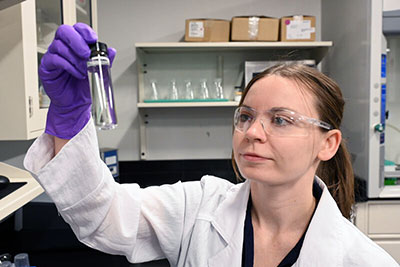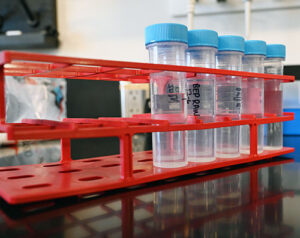
Louisville Water’s priority is public health, providing the community with excellent drinking water quality. The Environmental Protection Agency (EPA) has finalized the regulatory standards for a group of PFAS chemicals. The scientific terminology can be confusing, but the bottom line is Louisville Water meets the regulation and your drinking water is high-quality.
What is PFAS?
The EPA has finalized regulatory standards for six PFAS compounds. PFAS stands for per-and polyfluoroalkyl substances and are manufactured chemicals that do not naturally occur. There are thousands of PFAS chemicals, and they have been used in industry and consumer products since the 1940s. Because these chemicals are durable in most environments and do not break down, scientists detect PFAS in soil, water, air, and in people’s blood. Research indicates most of us are or have been exposed to PFAS. This final rule focuses on six of the chemicals that are more widely occurring and better studied. This rule is part of the National Primary Drinking Water Rules (NPDWR) that public water utilities follow to protect public health.
More about the Regulation and our Data
These new standards individually regulate the maximum allowable concentration (MCL) in drinking water for perfluorooctanoic acid (PFOA) and perfluorooctanesulfonic acid (PFOS), perfluorohexanesulfonic acid (PFHxS), perfluorononanoic acid (PFNA), and hexafluoropropylene oxide dimer acid (HFPO-DA), also known as GenX. In addition, perfluorobutanesulfonic acid (PFBS) along with PFHxS, PFNA and HFPO-DA are collectively regulated using a Hazard Index of 1 as the Maximum Contaminant Level (MCL) for all four compounds.
This new NPDWR will regulate the maximum allowable concentration (MCL) of PFOA and PFOS each at 4.0 parts per trillion (ppt), and PFHxS, PFNA and HFPO-DA each at 10 ppt based on a running annual average. The EPA is using a unitless Hazard Index of 1 for PFBS, PFHxS, PFNA, and HFPO-DA (GenX) in this new regulation.
Louisville Water’s PFAS data for our two water treatment plants is below, which is based on recently completed monitoring under EPA-required “Fifth Unregulated Contaminant Monitoring Rule” or UCMR 5. We report the data in parts per trillion with a running annual average for PFOS and PFOA and a Hazard Index for the other four PFAS chemicals.
PFAS Level in Louisville Water *
| PFAS Chemicals to be Regulated | Crescent Hill Water Treatment Plant | B.E Payne Water Treatment Plant | EPA Maximum Allowable Limit | Meets the Standard? |
|---|---|---|---|---|
| PFOS | 0 ppt | 0 ppt | 4.0 ppt | Yes |
| PFOA | 1.9 ppt | 0 ppt | 4.0 ppt | Yes |
| PFHxS | 0 ppt | 0 ppt | 10 ppt | Yes |
| PFNA | 0 ppt | 0 ppt | 10 ppt | Yes |
| HFPO-DA (GenX) | 0 ppt | 0 ppt | 10 ppt | Yes |
| PFBS, PFHxS, PFNA, and HFPO-DA (GenX) | 0 (Hazard Index) | 0 (Hazard Index) | 1 (Hazard Index) | Yes |
* Based on annual average of UCMR5 monitoring results collected in 2023
This table reflects the most recent data used by EPA to understand nationwide occurrence of PFAS. However, Louisville Water’s research scientists have monitored PFAS in our source water for the past 10 years to better understand seasonal variation and to monitor historical trends over time. Our research data is critical for guiding our treatment strategy and ensuring effective PFAS removal.
How Does EPA Determine the Regulation?
EPA regulations follow years of research, which included learning about the potential health impacts of PFAS at certain levels and how water utilities can manage the risk. The goal is to set the regulation at the lowest possible levels to protect public health considering feasibility and affordability.
The source of PFAS compounds in the Ohio River likely comes from various manufacturing facilities and products containing PFAS chemicals. While Louisville Water does not contribute to these contaminants occurring in the source of our drinking water, we continue to evaluate treatment options to reduce levels even lower than what we currently detect. These options include using activated carbon, which is a process Louisville Water already utilizes.
How am I exposed to PFAS chemicals?
Most of our exposure to PFAS chemicals comes from sources other than drinking water. PFAS are manufactured chemicals and these compounds do not naturally occur. EPA estimates most of our exposure to PFAS chemicals, more than 80%, comes from various consumer goods and not drinking water. In the 1940s, manufacturers began using these compounds to produce industrial and household items like non-stick cookware, waterproof fabric, fast-food packaging, pesticides, firefighting foam, and more. The use of PFAS has changed over time and many PFAS compounds are still used in manufacturing today, in cleaning projects, water-resistant fabrics, food packaging, non-stick cookware, personal care products, and stain-resistant coatings on carpets, furniture, and other fabrics.
In the mid-2000s, following research that indicated health concerns at low concentrations with two PFAS chemicals, PFOA and PFOS, some manufacturers voluntarily started phasing out the compounds. However, these chemicals are persistent, and because PFAS contaminants dissolve in water, scientists detect them in lakes, rivers, and groundwater. Although PFOA and PFOS are no longer manufactured in the United States, they have been replaced with other PFAS alternatives such as hexafluoropropylene oxide dimer acid (used in GenX technology) and perfluorobutanesulfonic acid (PFBS).
Research is Ongoing

Research and innovation never stop at Louisville Water. We have monitored our source waters and finished waters for PFAS for more than a decade and have conducted significant research on the feasibility and efficacy of various treatment approaches. We also participate in EPA’s work to monitor for contaminants that are not currently regulated. In 2023-2025, Louisville Water and thousands of other drinking water utilities monitor for 29 PFAS compounds as required by EPA’s Unregulated Contaminant Monitoring Rule. You can see the results of this research here.

